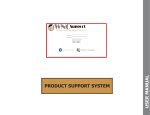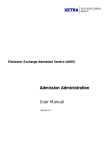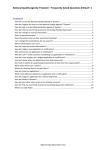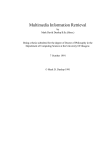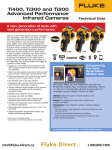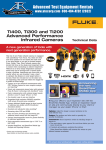Download Event Reports
Transcript
Event Reporting
User Manual
May 19, 2008
Event Reporting User Manual
Event Reports
An Event Report lets you track the identification, investigation, and resolution of any
issues affecting your fleet or business operation. Event Reports can be an important
element of your company's Quality Assurance (QA) program, Continuing Analysis And
Surveillance System (CASS), reliability program, or Safety Management System. For
more information about safety risk management, consult the U.S. FAA’s Safety Program
website (http://faasafety.gov/).
HAI’s Event Report program is accessible through the web at www.eventreporting.org,
or www.mmir.com. Registration only takes a few minutes. You can add and remove
additional users to your company’s account, with their own unique log-on.
An Event Report’s status can be New, Open, Closed, or Rescinded. When an Event
Report is initiated, its status is New. Once acknowledged by the designated
management representative (via checkbox), the report’s status is Open. An Open
report means that an issue has been identified, brought to management's attention, and
needs to be addressed. Authorized users can enter additional comments on Open
reports as an investigation ensues. Once the issue has been satisfactorily resolved and
documented, the Event Report should be classified as Closed. Once Closed, no further
entries or amendments are possible on the Event Report.
Authorized users may also rescind a New or Open Event Report, but this option should
be used sparingly. Rescinding an Event Report effectively nullifies the report without
resolution. The report remains stored in your company’s account for reference
purposes. Refer to User Levels section to determine the capabilities of authorized
users.
Event Reports are INTERNAL TO YOUR COMPANY unless specifically designated to
be SHARED (see Shared Reports section). Unlike MMIR reports that you send to the
FAA or the part manufacturer, your Event Reports are ONLY ACCESSIBLE TO
AUTHORIZED COMPANY EMPLOYEES, unless designated as SHARED.
The information in an Event Report can easily be copied to a MMIR form, if deemed
appropriate. For example, after an Event Report is filed, it may be determined that a
defective part was at fault. You have the option to transfer information from the Event
Report to a MMIR form, allowing for quick submission of a warranty claim or SDR. The
Event Report stays permanently in your account.
These topics are explained further in this manual.
1
Registration
If you use MMIR, you may already have an Event Report account. Check with your
company MMIR administrator. The log-on name and password will be the same for
both systems.
To register a new Event Report account, go to www.eventreporting.org or
www.mmir.com. and click on the “Not registered? Click here” link. Registration only
takes a few minutes; simply follow the step-by-step process. You can add and remove
additional users to your company’s account, each with their own unique log-on.
Begin
registration
here
During registration, you will be asked for a log-on email address and a password. You
will use this email / password combination to log onto the Event Reporting system. Be
sure to use a real email address. You will be notified at this address whenever a new
Event Report is entered into your company’s account.
You will also be asked if you want to activate “Anonymous Reporting.” This is a special
feature of Event Reporting. Anonymous Reporting allows all company employees to
submit a report without personal identification, hence, anonymously. Why? Employees
may feel more comfortable reporting potential problems without fear of personal
2
retribution. Whether this fear is warranted or not, many companies have found that just
having the option available to employees offers another avenue to identify and fix small
issues, before they become big trouble.
Enter strong
password
Enter a strong password, then click Continue. A new web page will be generated. It will
show your computer-generated Company ID number and your Anonymous Reporting
password.
This Anonymous Reporting feature can be turned on or off as you deem appropriate.
Use the “Edit Users” link on the Main Menu.
3
Print and
distribute
Because this is the information your employees will need to log on and submit an
Anonymous Report, we suggest you use the “Print this Page” link. To get an even
cleaner copy that you can post on the company bulletin board, drop in employees’ mail
slots, or disseminate via company email, click on the PDF Version link.
This Anonymous Event Reporting narrative page, which includes your Company ID /
Password, is also accessed from the Authorized Users page.
4
On the Authorized Users page (click “Edit Users” from the Main Menu), you can add
additional users for your Event Reporting account. Generally, this will be limited to
specific employees who will be authorized to create, edit, or respond to Event Reports.
Authorized users can be added, amended, or deleted anytime.
Add, edit, or
delete users
on your
company
account
Find your
company’s
Anonymous
Report
Company ID /
password
Enable / disable
toggle button; or
change password
Every additional user
must have a unique
email and password
Select a User Level
for each user
5
User Levels
There are four User Levels for Event Reporting. Higher levels retain the capabilities of
lower levels:
Read allows the user to view existing Event Reports only.
Write authorizes the user to initiate a ("New") report and edit (add information and
comments) existing company reports. This is an appropriate level for employees who
have reason to report and/or comment on problems or observations.
Manager controls the dispensation of Event Reports; i.e., Acknowledge, Close, and
Rescind. See “Working with Event Reports” for explanation.
Administrator controls other users' levels of authorization, and adds or removes users
from the system. Administrators are notified via email when a new Event Report is
submitted. The person who registers for the company account is automatically
designated an Administrator.
6
Working with Event Report Forms
To start a report, log on, and from the Main Menu, select "New Event Report"
Start here
Event Report Form
The Event Report form is structured to let you assign general categories pertaining to
subject and urgency of resolution. You can also designate the time of the event
occurrence, and if applicable, the specific aircraft and/or engine. The important point to
remember is to USE THE FORM AS YOU SEE FIT. Unlike SDR or warranty claim
forms, there are no required fields on the Event Report form. Just provide enough
information to help with your operation.
7
Company information,
report status, overview
Ratings;
occurrence date & time
Broad categories:
• Ground Operations
• Flight Operations
• Maintenance
• Administrative
Multiple subcategories
User-customizable locations
User-customizable topics
Aircraft, Engine; SDR, MIS fields
(if applicable)
Check for related reports
Narrative boxes
(text)
Part(s) information
Accountability record;
all previous versions
available for review
Once report is “Open,” Manager level
can “Close” report when resolved and
documented; or Rescind report
8
Anonymous User Reports
There is growing understanding that to encourage the reporting of problem areas and
safety-related issues by all employees, a business climate must exist in which
identifying and correcting problems takes precedence over assigning fault and metering
punishment. To work towards that goal of a “Just Culture,” Event Reporting provides
the option for users to submit Event Reports anonymously. It is up to management to
decide whether or not to utilize this feature, or whether to continue it. To allow
anonymous reporting, the MMIR Account Administrator must select that option on the
Registration form (“Edit Registration & Users” link on the Main Menu). A strong
password must be selected (at least 8 alpha and 1 numeric characters), and a
Company ID is automatically assigned. This Company ID / password log-on should be
made available to all company employees, and not revealed outside the company. An
anonymous Event Report filed using this log-on is directed to your company.
Anonymous Users can only initiate Event Reports; they have no User Level
authorization. NOTE: An employee does not have to be a registered user to submit an
Anonymous Event Report.
Anyone with the correct Company ID / password log-on can access Anonymous
Reporting at www.eventreporting.org. Just click on the “File Anonymous Event Report”
link:
Start here to
submit an
Anonymous
Report
How Event Reports are Processed
When someone initiates an Event Report, its status is New. The report remains in New
status until a Manager (or higher User Level) reviews the report and checks the “Click
here to acknowledge this report” box (just beneath the large Describe Event text box).
9
Once the report is acknowledged, its status changes to Open. Authorized users (those
with access to your company’s account; i.e., Additional Users) can log on to Event
Reporting anytime and review or add details to the Event Report. ANYONE WHO
ACCESSES OR EDITS AN EVENT REPORT HAS THEIR INITIALS ASSIGNED TO
THAT REPORT. By tracking who has accessed an Event Report, accountability is
provided. This accountability trail is listed under the “History” section, including dates
and times. EXCEPTION: Anonymous Users are only identified as “Anonymous.”
Probably the most important features of the Event Report form are the 3 text boxes:
Describe Event, Investigations & Findings, and Resolution. Here, authorized users
describe in their own words what happened, keep track of findings as an investigation
progresses, and document the resolution for future reference. An Event Report can be
accessed and edited by authorized company users indefinitely, until the report is Closed
or Rescinded.
Closed: An Event Report is designated as Closed by a Manager or higher User Level
(via the checkbox at the bottom of the form) when the issue has been satisfactorily
resolved and documented. Remember, someone in your company may review this
form years later, so make the report detailed enough to be helpful. After checking the
Closed box, you can specify the date on which the report was closed, and the initiator of
the Event Report will be notified via email (unless Anonymous). Also, you will be given
the option to “share” your Event Report; i.e., make it available to be read by external
parties. Once Closed, the Report is reviewable, but no longer editable.
Rescinded: A Manager User Level or higher may also rescind a New or Open Event
Report, but this option should be used sparingly. Rescinding an Event Report
effectively nullifies the report without resolution. The report remains stored in your
company’s account for reference purposes.
Summarizing, you Close an Event Report when the issue has been resolved and
documented. You may Rescind an Event Report if you believe the underlying issue did
not warrant action. Only a Manager User Level or higher can Close or Rescind an
Event Report.
Note that there is no Delete option for Event Reporting. In other words, once started,
the Report will remain available indefinitely, for review. It can stay in New or Open
status indefinitely as well. There is one exception:
10
This is the menu you will see after you Save your Event Report. You can review it, edit
it, print it out, create a new Event Report, search for existing Event Reports, go to the
Main Menu, copy the data from the Event Report to a MMIR form, or log off.
IF YOU HAVE JUST INITIATED A REPORT, you have the option, just this time, to
delete it. THIS IS THE ONLY TIME YOU CAN ACTUALLY DELETE AN EVENT
REPORT; i.e., immediately after starting it. The next time any authorized user
(including the initiator) accesses this report, the Delete option will be unavailable.
11
Remember, an Event Report “goes nowhere” unless you specifically designate it as
“Shared” when you close it. If the Event Report is not shared, only authorized users on
your company’s Event Report account have access to it.
Related Event Reports
Over time, you will probably create dozens or hundreds of Event Reports. Inevitably,
some will overlap in some way. That is, the same or similar issue may re-appear.
Wouldn’t it be useful to be able to tie these report references together? You can with
Event Reporting. If there are other Event Reports, within your company of course, that
might be related to the report you are working on, it’s easy to reference them. And you
don’t have to rely on your memory. Simply check the box where it says, “Check here if
this report is related to other Event Reports.”
A new text box will appear. If you remember the report number, type it in here. More
than likely though, you’ll want to click the Search button.
Check this box
if you think
other reports
may be relevant
Review your
reports to
determine
relevance
A chronological list of all your company’s Event Reports appears. You can review
individual reports, and check to insert their numbers into the current report if
appropriate.
12
Search and Review Event Reports
So how do you go in and find Event Reports? Easy. From the Main Menu, select
“Search Event Report.” The following search form will appear:
If you want to review and edit your company’s Event Reports, just click the Submit
button. If you are interested in viewing external (other companies’) Shared Event
Reports, select the appropriate option, then click Submit. Searching on “Company
Reports” will bring up the following search screen:
13
If you know the record number, just enter it in the Record # box at the top and click the
Go! button. Otherwise, search on any or all fields under the Comprehensive Search
banner. The date range defaults to the past year, but change that to your preference.
Another helpful feature is the keyword search. Let’s say you remember something you
wrote in one of the text fields, such as Investigation & Findings: “The pilot reported a
click clack noise on shutdown.” To quickly find the report, you could type a clause as
you remember it; e.g., click clack. A list would appear that includes all Event Reports
with that text in any of the 3 narrative text fields.
Shared Reports
What is the advantage of sharing your company’s information? Depending on the
nature of the event, sharing information can be positive for safety. You will have to
make that determination when you Close your Event Report. You will be given the
opportunity to designate the report for sharing with others. This means that external
parties, even your competitors, will be able to review that specific Report, unaltered and
in full.
!TIP While anyone may view a Shared Event Report, no one can amend or edit it.
14
HAI believes safety is enhanced when information is shared. A documented problem
and its resolution could be helpful to other operators who might be experiencing similar
issues, or make them aware of potential trouble. HAI recommends sharing information
whenever competitive interests are not infringed. Who knows...someone else’s shared
Event Report may help you one day.
If you have comments about Event Reporting, contact HAI at [email protected], or
+1 (703) 683-4646.
15
Dedicated to the advancement of the international helicopter community



















